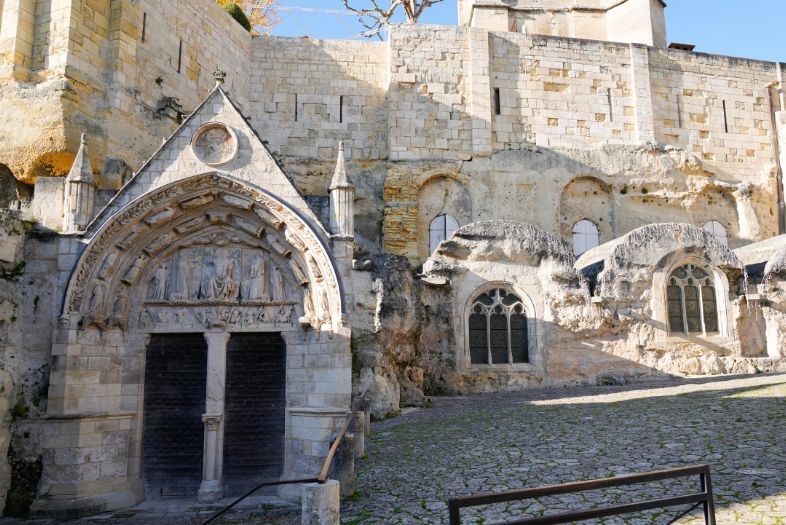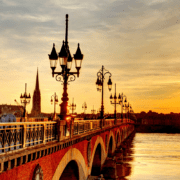
Monolithic church of Saint Émilion: treasures in stone
In the heart of the picturesque Bordeaux wine region, stands a monument that encapsulates centuries of history and an astonishing testament to faith and human skill: the monolithic Church of Saint Émilion. This impressive temple, sculpted entirely from a single piece of solid rock, is not just an architectural marvel,
As we explore it, we are immersed in a journey that transcends a simple visit to a historical site. It is a pilgrimage into the soul of a community that has thrived around this magnificent structure. From its enigmatic catacombs to its dizzying heights, every inch tells a part of this town’s rich history.
To fully discover this treasure, you can join a free tour of Saint Emilion. You will gain a deeper insight into this unique place.
History of the monolithic church
The history of this structure is as deep and fascinating as the catacombs hidden beneath its foundations. After visitors indulge in a wine tasting at Saint Emilion, they can immerse themselves in the narratives that have shaped this unique place, an essential reference point for understanding what to see in Saint Emilion.
Its origins date back to the beginning of the 12th century, although its construction was a centuries-long process, reflecting the changes and turbulences of the time.
It was carved directly into a massive block of limestone, a testament to the skill and determination of medieval craftsmen. Its construction coincided with a period of great religious and economic importance in the region, marked by the rise of Christian pilgrimage and the growth of the wine industry.
This period saw the region establish itself as a place of strategic and spiritual importance, attracting pilgrims, merchants and wine lovers alike.
Over time, it has witnessed and participated in numerous historical events. From wars and regional conflicts to changes in religious practices, each stage of its history has left a mark on its structure and the surrounding community.
Today, it is well worth visiting Saint Emilion and exploring this magnificent monument, which remains as vital to the region’s identity as it was hundreds of years ago.
Architecture and design
As you explore this hidden treasure among the pretty villages near Bordeaux, you will find yourself immersed in a world where architecture and history merge in spectacular fashion.
As we have already told you, this cave church is carved entirely out of a single piece of limestone rock. Imagine entering a space that has been excavated, not built, where every wall, column and vault has been meticulously carved from the same stone.
The craftsmen of the time, without the aid of modern machinery, excavated the stone with basic tools, creating an underground sacred space of massive proportions. In fact, this sanctuary is the culmination of a cave extension.
Another detail that cannot be overlooked is its gigantic dimensions. In fact, it is the largest example of a religious building of this style. As a counterpoint, it is true that it includes various Gothic elements, such as its doorway.
On closer inspection, you will notice how the monolithic nature of the church contributes to its impressive acoustics. The solid stone walls, combined with the high vaulted ceilings, create a unique sound environment, ideal for choral music and church services.
In addition, the absence of traditional windows and the use of small openings for light add an air of mystery and reverence to this sacred space. The church has a network of catacombs and underground passages, each with its own history and purpose: from the burial of saints and nobles to the celebration of secret rituals.
The bell tower
As we have already mentioned, this monument was built over several centuries. The bell tower was erected between the 12th and 15th centuries. Its robust and elegant design shows the transition from the Romanesque to the Gothic style. It is a symbol of the architectural evolution and ecclesiastical power of the time.
Ascending the 196 steps (it is 68 metres high) can be a challenge, but offers the reward of spectacular views of the city and its surroundings. It is generally open to the public every day of the year, except for special occasions.
Treasures in Stone: Artistic Details and Symbolism
As you enter this place, you will find yourself surrounded by an amalgam of artistic and symbolic details that speak of the rich cultural and spiritual heritage of this monument. Each sculpture, relief and decorative element has its own story, and as you discover it, you will unravel the hidden meanings that have captivated visitors for centuries.
You will find figures carved directly into the stone, representing saints, angels and biblical episodes. They are not just decorations, they are visual narratives that communicated sacred stories to a largely illiterate population in the Middle Ages.
The reliefs in the church are equally impressive. Look at the patterns and scenes they depict: from intricate depictions of the Last Supper to complex scenes of the Last Judgement.
Be sure to pay attention to the smaller decorative elements, such as the capitals of the columns and the edges of the arcades. Often these elements contain more subtle symbolism: the depiction of vine leaves and bunches of grapes, for example, not only reflect the importance of viticulture in the region, but also the biblical symbolism of wine as the blood of Christ.
The church in local culture
The church has for centuries been the spiritual and cultural heart of its community. It has played a central role in the life of the inhabitants, being the setting for countless events, from religious ceremonies to local festivities.
The festivals and traditions associated with the church are a vibrant reflection of Saint Émilion’s culture. For example, during the grape harvest season, it becomes a place of celebration, where the community gathers to give thanks and ask for blessings for the harvests.
At every visit, every mass and every festival, it remains a symbol of unity and a reminder of the rich heritage that defines Saint Émilion. Its influence on the local community is a palpable testimony to how a place of faith can become the soul of a people.
Tourist experience in the monolithic church
When you visit this place, be prepared for a unique experience. An architectural marvel awaits you, with a serene and spiritual atmosphere. To make the most of your visit:
- Try to arrive early, especially in high season, to avoid the crowds.
- Although the church is accessible, be aware that some areas may be difficult to navigate for people with reduced mobility due to their nature.
- Wear comfortable shoes for hassle-free exploring.
- Don’t forget your camera to capture the beauty of its architectural details.
- If possible, join a guided tour to enrich your experience with fascinating stories and facts.



